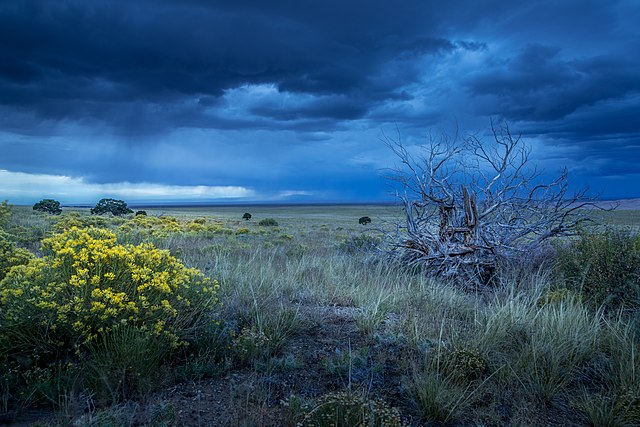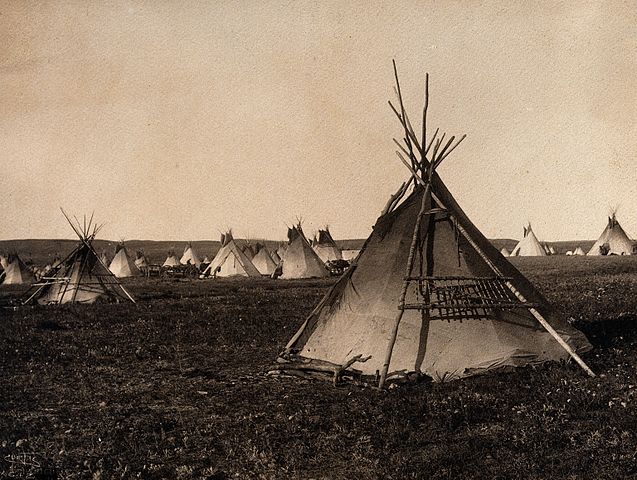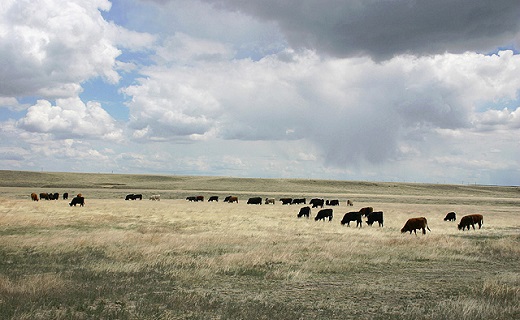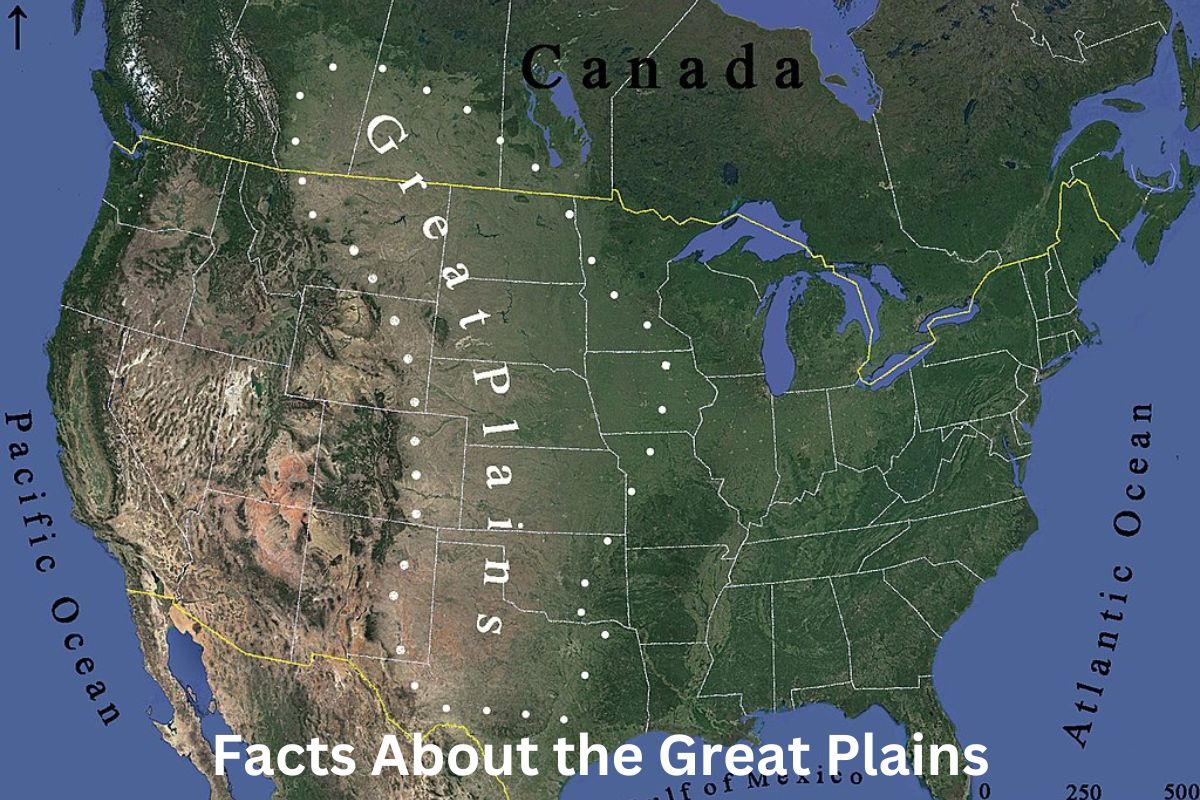The Great Plains are a large region of North America that includes sections of both the United States and Canada.
It is a vast grassland that stretches from the Rocky Mountains in the west to the Mississippi River in the east, covering an area of approximately 1.8 million square kilometers (700,000 square miles).
The Great Plains support a vast range of plant and animal life, as well as several Native American tribes and large natural resource reserves.
Extreme weather conditions, including as scorching summers and freezing winters, as well as violent thunderstorms, tornadoes, and blizzards, are common in the region.
The Great Plains is an important agricultural region that produces crops such as wheat, corn, and soybeans, as well as oil, natural gas, and coal.
The region has a rich cultural heritage and has played a significant part in defining North America’s history and development.
Great Plains Facts
1. The Great Plains is located between the Rocky Mountains to the west and the Mississippi River
The Great Plains is located between the Rocky Mountains to the west and the Mississippi River to the east. The region encompasses sections of both the United States and Canada and is distinguished by its vast grasslands, rolling hills, and peculiar climate.
The Rocky Mountains define the western boundary of the Great Plains, while the Mississippi River and its tributaries form the eastern boundary.
This geographical location has had a profound impact on the region’s climate, ecology, and culture, as well as shaping North America’s history and development.
2. The Great Plains support a wide variety of wildlife
The Great Plains support a wide variety of wildlife, including large mammals such as bison, pronghorn antelope, and coyotes, as well as smaller creatures such as prairie dogs, rabbits, and many bird species.

Traditionally, enormous herds of bison roamed the Great Plains, providing an essential resource for many Native American tribes. Bison populations are substantially smaller today, but attempts are underway to return them to their original ranges.
The Great Plains also supports a diverse range of grasses and wildflowers, which provide critical habitat and food for the region’s fauna.
3. The Great Plains region has a long history of Native American culture
The Great Plains region has a long history of Native American culture and is home to numerous indigenous tribes such as the Sioux, Cheyenne, Comanche, and others.
These tribes have lived on the Great Plains for thousands of years, and their civilizations are inextricably linked to the region’s natural environment.

Many Great Plains Native American tribes were nomadic, following the migration of bison herds and relying on them for food, clothing, and shelter.
The Great Plains also played an important role in the history of the United States’ westward expansion, including wars between Native American tribes and European settlers.
Many Native American communities on the Great Plains are still preserving and celebrating their cultures and customs today.
4. The Great Plains are noted for their harsh weather conditions
The Great Plains are noted for their harsh weather conditions, which include hot summers and freezing winters.
Summers in the Great Plains may be hot and dry, with daytime temperatures frequently exceeding 30°C (90°F).
Winters, on the other hand, can be severely cold, with temperatures frequently falling well below freezing and snowfall occurring on a regular basis.

Apart from these extremes, the Great Plains is noted for its frequent thunderstorms, tornadoes, and blizzards, all of which can have a substantial impact on the region’s ecological and human populations.
The Great Plains’ harsh weather conditions have had a considerable impact on the region’s natural ecosystem, including the creation of grasslands and the prevalence of specific plant and animal species.
5. Thunderstorms, tornadoes, and blizzards are common in the Great Plain
Severe thunderstorms, tornadoes, and blizzards are common in the Great Plains, especially during the spring and summer months. The area is known as “Tornado Alley” because of the frequency with which tornadoes occur there.

Thunderstorms on the Great Plains can be especially severe, with numerous lightning strikes, high winds, and heavy rainfall. These storms have the potential to produce flash floods, hailstorms, and other sorts of severe weather.
In the winter months, blizzards are also prevalent, with strong winds, thick precipitation, and subzero temperatures. The Great Plains’ harsh weather conditions can be hazardous to both human populations and wildlife in the region.
6. The Great Plains, sometimes known as North America’s “breadbasket”
The Great Plains, sometimes known as North America’s “breadbasket,” is an important agricultural region that produces a range of commodities such as wheat, corn, soybeans, and other grains.
The lush soil, plentiful water supply, and relatively flat geography of the region make it ideal for large-scale agricultural. Wheat is the main crop farmed in the Great Plains, with Kansas, Nebraska, and North Dakota producing the most.
Corn and soybeans are also major crops in areas such as Iowa and Illinois. In addition to these crops, the Great Plains also produces meat and dairy products, as well as cotton, sorghum, and sunflowers. The agricultural industry contributes significantly to the region’s economy.
7. The Great Plains is rich in natural resources
The Great Plains is also rich in natural resources, including oil, natural gas, coal, and uranium. The region is a major producer of oil and natural gas, having large deposits in states such as Texas, Oklahoma, and North Dakota.
Coal mining is also a significant industry in some Great Plains states, including Wyoming and Montana. Uranium deposits can also be discovered in the region, most notably in Wyoming, South Dakota, and Nebraska.
The mining and processing of these natural resources has had a tremendous economic influence on the region, but it has also had substantial environmental consequences.
The balance between the economic benefits of resource extraction and the potential detrimental impacts on the environment and local communities is still being debated today.
8. The Great Plains have a rich cultural past
The Great Plains have a rich cultural past and have been the venue of numerous historic events and movements.
The Lewis and Clark expedition of 1804-1806, for example, investigated the Great Plains and contributed to a better understanding of the region’s geography and ecology.
The Great Plains also saw significant confrontations between Native American tribes and the United States government, such as the Battle of Little Bighorn in 1876, often known as “Custer’s Last Stand.”
Furthermore, the Great Plains were important in the formation of the cowboy and cattle ranching culture of the American West, with legendary figures such as Buffalo Bill Cody and Wild Bill Hickok linked with the region.
Today, the Great Plains remains an important cultural hub, with several festivals, museums, and cultural events honoring the region’s distinctive history and legacy.
9. Fenneman named 25 regions in the USA, including the Great Plains
Nevin Fenneman was a geographer in the United States best known for his 1916 research “Physiographic Subdivision of the United States.” This study was a watershed moment in physical geography, helping to develop a method for classifying and charting landforms in the United States.
Fenneman classified the United States into 25 physiographic regions, each having its own distinct characteristics such as landforms, geology, climate, and vegetation. Fenneman named 25 regions, including the Great Plains, which were described as a large tract of gently rolling hills and grasslands stretching from the Rocky Mountains to the Mississippi River.
Fenneman’s research was a significant contribution to the discipline of physical geography, and it aided in the development of a framework for understanding the different physical landscapes of the United States. His work influenced subsequent research in the topic and is an important resource for geographers and other researchers interested in North American geography.
10. The Great Plains can be divided into several larger sub-regions
The Great Plains can be divided into several larger sub-regions, each with its own unique characteristics. While the exact boundaries of these sub-regions can vary depending on the source, some common sub-regions include:
- High Plains: Located in the western portion of the Great Plains, the High Plains are characterized by a semi-arid climate, with low precipitation and high evaporation rates. The region is also known for its high winds and occasional tornadoes. Major cities in the High Plains include Lubbock, Texas, and Amarillo, Texas.
- Central Plains: This sub-region covers the central portion of the Great Plains, including parts of Kansas, Nebraska, and Oklahoma. The Central Plains are characterized by rolling hills and fertile soil, and are an important agricultural region. Major cities in the Central Plains include Wichita, Kansas, and Oklahoma City, Oklahoma.
- Northern Plains: The Northern Plains include parts of Montana, North Dakota, and South Dakota, and are characterized by cold winters, short summers, and relatively low precipitation. The region is home to a variety of wildlife, including bison, pronghorn, and elk. Major cities in the Northern Plains include Bismarck, North Dakota, and Rapid City, South Dakota.
- Southern Plains: The Southern Plains include parts of Texas, Oklahoma, and Kansas, and are characterized by a hot, humid climate and frequent thunderstorms. The region is an important agricultural area, producing a variety of crops, including cotton, wheat, and sorghum. Major cities in the Southern Plains include Dallas, Texas, and Oklahoma City, Oklahoma.
- Edwards Plateau: This sub-region is located in central Texas and is characterized by its rocky terrain and dry climate. The Edwards Plateau is an important grazing area for cattle and is also known for its unique flora and fauna, including the Texas horned lizard and the golden-cheeked warbler. Major cities in the Edwards Plateau include Austin, Texas, and San Antonio, Texas.
These sub-regions help to illustrate the diversity of the Great Plains region and the unique characteristics of each area.
